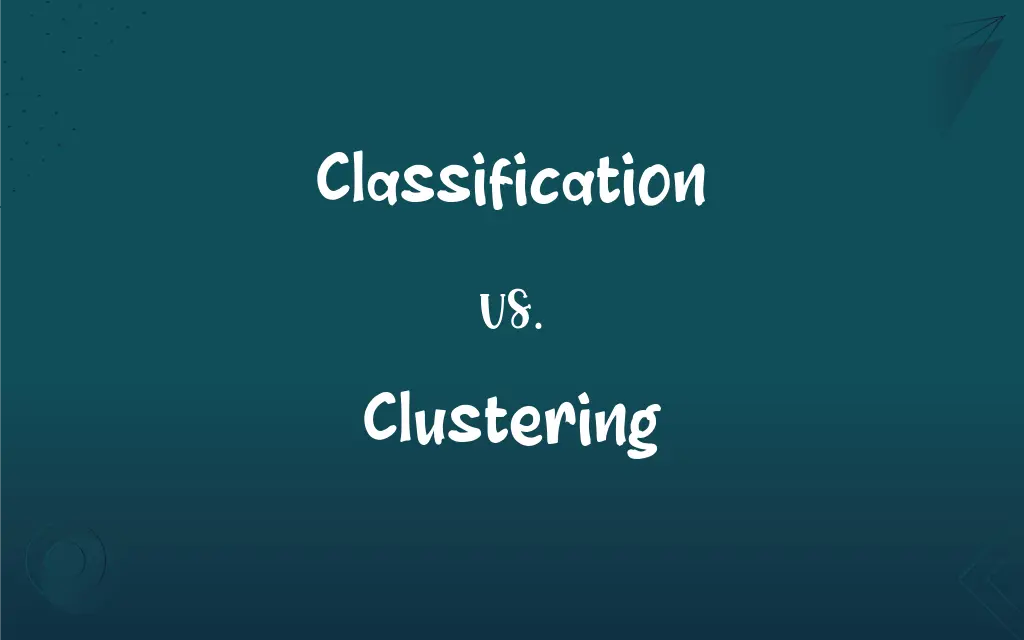Classification vs. Clustering: What's the Difference?
Edited by Aimie Carlson || By Harlon Moss || Published on February 29, 2024
Classification is assigning predefined labels to data, while clustering involves grouping data into subsets based on similarities without predefined labels.

Key Differences
Classification is a supervised learning technique in machine learning where the algorithm is trained on a labeled dataset. It involves categorizing data into predefined classes or groups based on their attributes. For example, classifying emails into 'spam' or 'non-spam' is a common classification task. Clustering, on the other hand, is an unsupervised learning technique that groups a set of objects in such a way that objects in the same group (a cluster) are more similar to each other than to those in other groups. It does not use predefined labels but rather discovers the grouping in the data.
In classification, the categories or labels are known beforehand, and the algorithm learns from the training data how to assign new unseen data to these categories. It requires labeled training data where each instance is tagged with the correct answer. Clustering, however, does not have a training phase or predefined categories. The algorithm tries to group the data based on similarity measures, such as distance metrics, without any prior knowledge of the group definitions.
Classification algorithms need to be trained with a large and diverse set of labeled data to perform accurately. It is used in applications like sentiment analysis, image recognition, and fraud detection. In contrast, clustering is used in exploratory data analysis to find hidden patterns or groupings in data, such as customer segmentation in marketing, gene sequence analysis in biology, or organizing a large library of documents.
Examples of classification algorithms include decision trees, support vector machines, and neural networks. These methods require a clear definition of classes and a robust training phase. Clustering algorithms like K-means, hierarchical clustering, and DBSCAN, on the other hand, explore the data structure, identifying groupings based on the intrinsic distribution of data points.
The performance of a classification algorithm is usually evaluated based on accuracy, recall, and precision. It’s about how well the model assigns the correct label to new instances. For clustering, evaluation is trickier as there are no predefined labels; metrics like silhouette score or within-cluster sum of squares are used to measure the quality of the clusters formed by the algorithm.
ADVERTISEMENT
Comparison Chart
Type of Learning
Supervised learning
Unsupervised learning
Use of Labels
Uses predefined labels
Does not use predefined labels
Training Requirement
Requires training with labeled data
Does not require training with labeled data
Goal
To assign labels to new data based on learned patterns
To find natural groupings in the data
Evaluation Metrics
Accuracy, recall, precision
Silhouette score, within-cluster sum of squares
ADVERTISEMENT
Example Algorithms
Decision trees, neural networks
K-means, hierarchical clustering
Application Examples
Image recognition, spam detection
Customer segmentation, document organization
Classification and Clustering Definitions
Classification
A supervised learning method in machine learning.
We used a classification model to predict customer churn.
Clustering
Utilizes algorithms like K-means and hierarchical clustering.
We used K-means clustering to organize articles into thematic groups.
Classification
Used in applications like sentiment analysis and fraud detection.
Our fraud detection system uses classification to identify suspicious transactions.
Clustering
An unsupervised learning technique in data analysis.
We applied clustering to explore patterns in the unlabelled dataset.
Classification
Assigning data to predefined categories based on features.
The system's classification algorithm accurately identified the animal in the image as a cat.
Clustering
Commonly used in exploratory data analysis.
Clustering helped us understand the various customer segments in our market research.
Classification
Relies on a labeled dataset for training.
The algorithm's classification accuracy improved with a larger training dataset.
Clustering
Grouping data points into subsets based on similarity.
Clustering was used to segment customers based on purchasing behavior.
Classification
Involves labeling data into distinct groups.
The classification of emails into 'spam' or 'non-spam' helps filter unwanted messages.
Clustering
Identifies natural groupings in data without predefined labels.
The clustering algorithm revealed three distinct groups in the dataset.
Classification
The act, process, or result of classifying.
Clustering
A group of the same or similar elements gathered or occurring closely together; a bunch
"She held out her hand, a small tight cluster of fingers" (Anne Tyler).
Classification
A category or class.
Classification
(Biology) The systematic grouping of organisms into categories on the basis of evolutionary or structural relationships between them; taxonomy.
Classification
The act of forming into a class or classes; a distribution into groups, as classes, orders, families, etc., according to some common relations or attributes.
Classification
The act of forming into a class or classes; a distribution into groups, as classes, orders, families, etc., according to some common relations or affinities.
Classification
The act of distributing things into classes or categories of the same type
Classification
A group of people or things arranged by class or category
Classification
The basic cognitive process of arranging into classes or categories
Classification
Restriction imposed by the government on documents or weapons that are available only to certain authorized people
FAQs
What is clustering in data analysis?
An unsupervised learning technique that groups data based on similarities.
What is classification in machine learning?
A supervised learning process that categorizes data into predefined labels.
How does classification differ from clustering?
Classification uses predefined labels, while clustering groups data without them.
Can clustering be used for prediction?
No, it's typically used for exploratory analysis, not prediction.
Is labeled data required for classification?
Yes, classification requires a labeled dataset for training.
How is the success of clustering measured?
Using metrics like the silhouette score or within-cluster sum of squares.
What role does classification play in AI?
It's crucial for tasks requiring accurate categorization of data.
What are common clustering algorithms?
K-means, DBSCAN, and hierarchical clustering.
Can clustering be used in image processing?
Yes, for tasks like image segmentation and pattern identification.
Are neural networks used in classification?
Yes, they're a powerful tool for complex classification tasks.
What are examples of classification problems?
Email spam detection, disease diagnosis, and sentiment analysis.
In what scenarios is clustering used?
In customer segmentation, pattern recognition, and data organization.
Is decision tree a classification algorithm?
Yes, decision trees are a common method for classification.
How is classification accuracy evaluated?
Through metrics like precision, recall, and confusion matrices.
Are there hybrid approaches combining classification and clustering?
Yes, some advanced methods use both for comprehensive data analysis.
Does clustering require feature selection?
Effective feature selection can significantly improve clustering results.
How important is data visualization in clustering?
Visualization is key to interpreting clustering results and understanding data structures.
Can classification handle numerical and categorical data?
Yes, but the data might need preprocessing.
What is the impact of data quality on clustering?
Poor data quality can lead to misleading clustering outcomes.
What makes clustering challenging?
Determining the right number of clusters and interpreting the results.
About Author
Written by
Harlon MossHarlon is a seasoned quality moderator and accomplished content writer for Difference Wiki. An alumnus of the prestigious University of California, he earned his degree in Computer Science. Leveraging his academic background, Harlon brings a meticulous and informed perspective to his work, ensuring content accuracy and excellence.
Edited by
Aimie CarlsonAimie Carlson, holding a master's degree in English literature, is a fervent English language enthusiast. She lends her writing talents to Difference Wiki, a prominent website that specializes in comparisons, offering readers insightful analyses that both captivate and inform.
































































